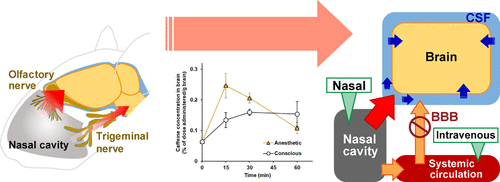当前位置:
X-MOL 学术
›
Mol. Pharmaceutics
›
论文详情
Our official English website, www.x-mol.net, welcomes your
feedback! (Note: you will need to create a separate account there.)
Effect of cerebrospinal fluid circulation on nose-to-brain direct delivery and distribution of caffeine in rats.
Molecular Pharmaceutics ( IF 4.5 ) Pub Date : 2020-09-21 , DOI: 10.1021/acs.molpharmaceut.0c00495 Daisuke Inoue 1, 2 , Tomoyuki Furubayashi 2, 3 , Akiko Tanaka 3 , Toshiyasu Sakane 3 , Kiyohiko Sugano 1
Molecular Pharmaceutics ( IF 4.5 ) Pub Date : 2020-09-21 , DOI: 10.1021/acs.molpharmaceut.0c00495 Daisuke Inoue 1, 2 , Tomoyuki Furubayashi 2, 3 , Akiko Tanaka 3 , Toshiyasu Sakane 3 , Kiyohiko Sugano 1
Affiliation

|
Direct drug delivery from nose to brain has drawn much attention as an effective strategy for the treatment of central nervous system diseases. After intranasal administration, drug molecules can be directly delivered from the nose to the brain. However, the detailed mechanism for this direct delivery to the brain has not been elucidated. In the present study, the effect of the activation of the cerebral fluid circulation (the glymphatic system) on the efficacy of direct delivery from nose to brain was investigated. Because the glymphatic system is activated by some anesthetic regimens, the differences in brain delivery and the pharmacokinetics under anesthetic and conscious conditions were compared in rats. Under urethane anesthesia, direct delivery from the nose to the brain was facilitated, whereas the brain uptake from the systemic circulation via the blood–brain barrier was decreased. In addition, both the brain uptake of caffeine injected into the subarachnoid cerebrospinal fluid (CSF) and the extracerebral clearance of caffeine after intrastriatal injection were enhanced under anesthesia. For intranasal administration, caffeine was transported directly from the nose to the CSF and then delivered into the brain parenchyma by the CSF circulation. The results obtained in the present study clarified that the direct delivery from nose to brain could be facilitated by anesthesia. These findings suggest that fluid circulation in the brain can contribute to a wider cerebral distribution of the drug after direct delivery from nose to brain.
中文翻译:

脑脊液循环对大鼠鼻-脑直接传递和咖啡因分布的影响。
从鼻子到大脑的直接药物递送作为治疗中枢神经系统疾病的有效策略引起了很多关注。鼻内给药后,药物分子可以直接从鼻子输送到大脑。然而,这种直接传递到大脑的详细机制尚未阐明。在本研究中,研究了脑液循环(类淋巴系统)的激活对从鼻子到大脑的直接输送效果的影响。由于某些麻醉方案激活了淋巴系统,因此在大鼠中比较了麻醉和清醒条件下大脑递送和药代动力学的差异。在氨基甲酸乙酯麻醉下,促进了从鼻子到大脑的直接输送,而通过血脑屏障从体循环中的大脑摄取减少。此外,在麻醉下,脑内对蛛网膜下脑脊液 (CSF) 中咖啡因的摄取和纹状体内注射后咖啡因的脑外清除率均得到增强。对于鼻内给药,咖啡因直接从鼻子输送到脑脊液,然后通过脑脊液循环输送到脑实质。本研究中获得的结果阐明,麻醉可以促进从鼻子到大脑的直接输送。这些发现表明,从鼻子直接输送到大脑后,大脑中的液体循环有助于药物在大脑中的更广泛分布。在麻醉下,脑内对蛛网膜下脑脊液 (CSF) 中咖啡因的摄取和纹状体内注射后咖啡因的脑外清除率均有所提高。对于鼻内给药,咖啡因直接从鼻子输送到脑脊液,然后通过脑脊液循环输送到脑实质。本研究中获得的结果阐明,麻醉可以促进从鼻子到大脑的直接输送。这些发现表明,从鼻子直接输送到大脑后,大脑中的液体循环有助于药物在大脑中的更广泛分布。在麻醉下,脑内对蛛网膜下脑脊液 (CSF) 中咖啡因的摄取和纹状体内注射后咖啡因的脑外清除率均有所提高。对于鼻内给药,咖啡因直接从鼻子输送到脑脊液,然后通过脑脊液循环输送到脑实质。本研究中获得的结果阐明,麻醉可以促进从鼻子到大脑的直接输送。这些发现表明,从鼻子直接输送到大脑后,大脑中的液体循环有助于药物在大脑中的更广泛分布。咖啡因直接从鼻子输送到脑脊液,然后通过脑脊液循环输送到脑实质。本研究中获得的结果阐明,麻醉可以促进从鼻子到大脑的直接输送。这些发现表明,从鼻子直接输送到大脑后,大脑中的液体循环有助于药物在大脑中的更广泛分布。咖啡因直接从鼻子输送到脑脊液,然后通过脑脊液循环输送到脑实质。本研究中获得的结果阐明,麻醉可以促进从鼻子到大脑的直接输送。这些发现表明,从鼻子直接输送到大脑后,大脑中的液体循环有助于药物在大脑中的更广泛分布。
更新日期:2020-11-02
中文翻译:

脑脊液循环对大鼠鼻-脑直接传递和咖啡因分布的影响。
从鼻子到大脑的直接药物递送作为治疗中枢神经系统疾病的有效策略引起了很多关注。鼻内给药后,药物分子可以直接从鼻子输送到大脑。然而,这种直接传递到大脑的详细机制尚未阐明。在本研究中,研究了脑液循环(类淋巴系统)的激活对从鼻子到大脑的直接输送效果的影响。由于某些麻醉方案激活了淋巴系统,因此在大鼠中比较了麻醉和清醒条件下大脑递送和药代动力学的差异。在氨基甲酸乙酯麻醉下,促进了从鼻子到大脑的直接输送,而通过血脑屏障从体循环中的大脑摄取减少。此外,在麻醉下,脑内对蛛网膜下脑脊液 (CSF) 中咖啡因的摄取和纹状体内注射后咖啡因的脑外清除率均得到增强。对于鼻内给药,咖啡因直接从鼻子输送到脑脊液,然后通过脑脊液循环输送到脑实质。本研究中获得的结果阐明,麻醉可以促进从鼻子到大脑的直接输送。这些发现表明,从鼻子直接输送到大脑后,大脑中的液体循环有助于药物在大脑中的更广泛分布。在麻醉下,脑内对蛛网膜下脑脊液 (CSF) 中咖啡因的摄取和纹状体内注射后咖啡因的脑外清除率均有所提高。对于鼻内给药,咖啡因直接从鼻子输送到脑脊液,然后通过脑脊液循环输送到脑实质。本研究中获得的结果阐明,麻醉可以促进从鼻子到大脑的直接输送。这些发现表明,从鼻子直接输送到大脑后,大脑中的液体循环有助于药物在大脑中的更广泛分布。在麻醉下,脑内对蛛网膜下脑脊液 (CSF) 中咖啡因的摄取和纹状体内注射后咖啡因的脑外清除率均有所提高。对于鼻内给药,咖啡因直接从鼻子输送到脑脊液,然后通过脑脊液循环输送到脑实质。本研究中获得的结果阐明,麻醉可以促进从鼻子到大脑的直接输送。这些发现表明,从鼻子直接输送到大脑后,大脑中的液体循环有助于药物在大脑中的更广泛分布。咖啡因直接从鼻子输送到脑脊液,然后通过脑脊液循环输送到脑实质。本研究中获得的结果阐明,麻醉可以促进从鼻子到大脑的直接输送。这些发现表明,从鼻子直接输送到大脑后,大脑中的液体循环有助于药物在大脑中的更广泛分布。咖啡因直接从鼻子输送到脑脊液,然后通过脑脊液循环输送到脑实质。本研究中获得的结果阐明,麻醉可以促进从鼻子到大脑的直接输送。这些发现表明,从鼻子直接输送到大脑后,大脑中的液体循环有助于药物在大脑中的更广泛分布。











































 京公网安备 11010802027423号
京公网安备 11010802027423号